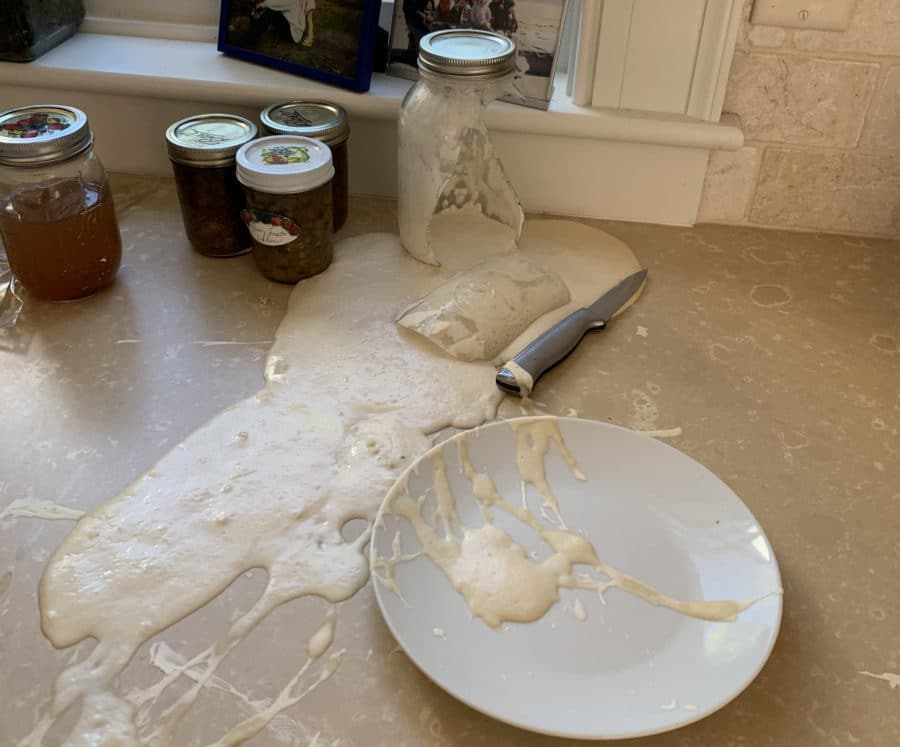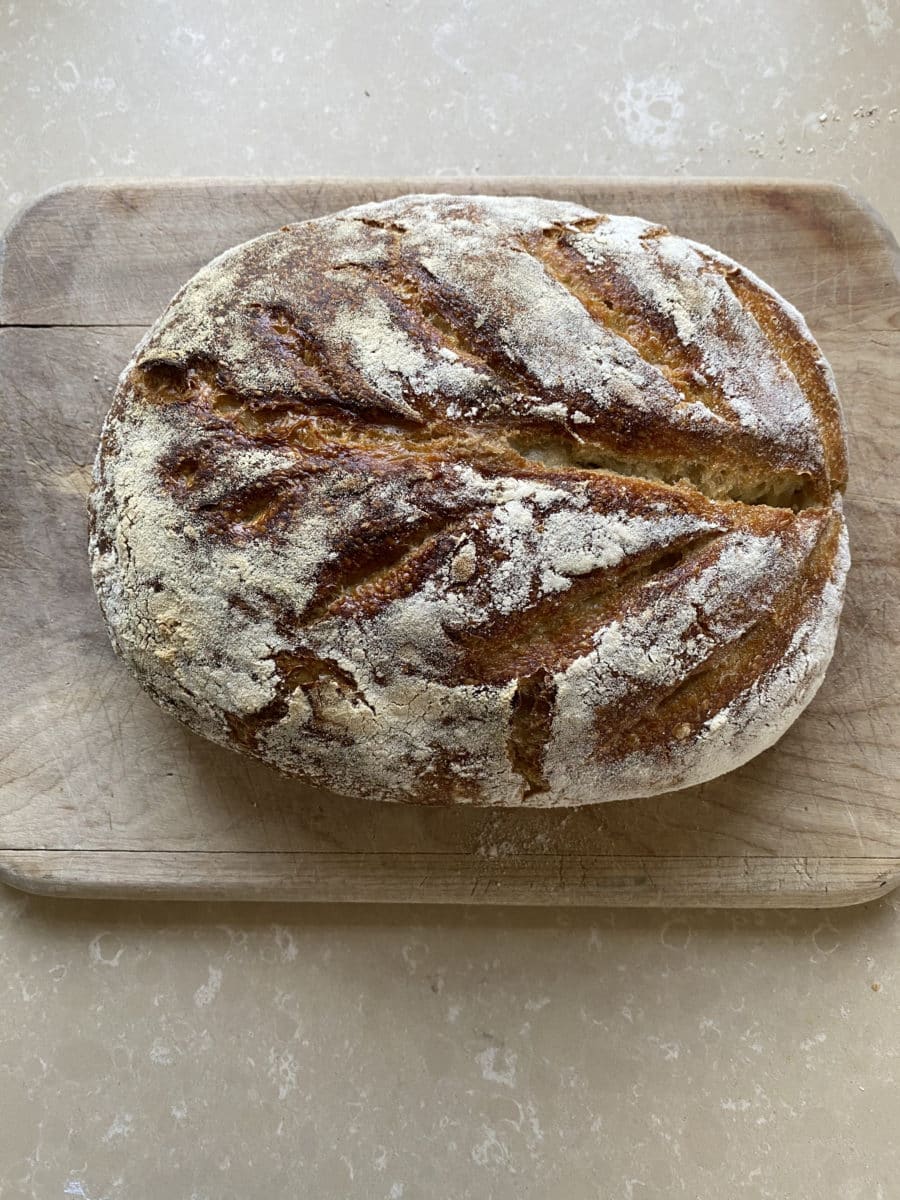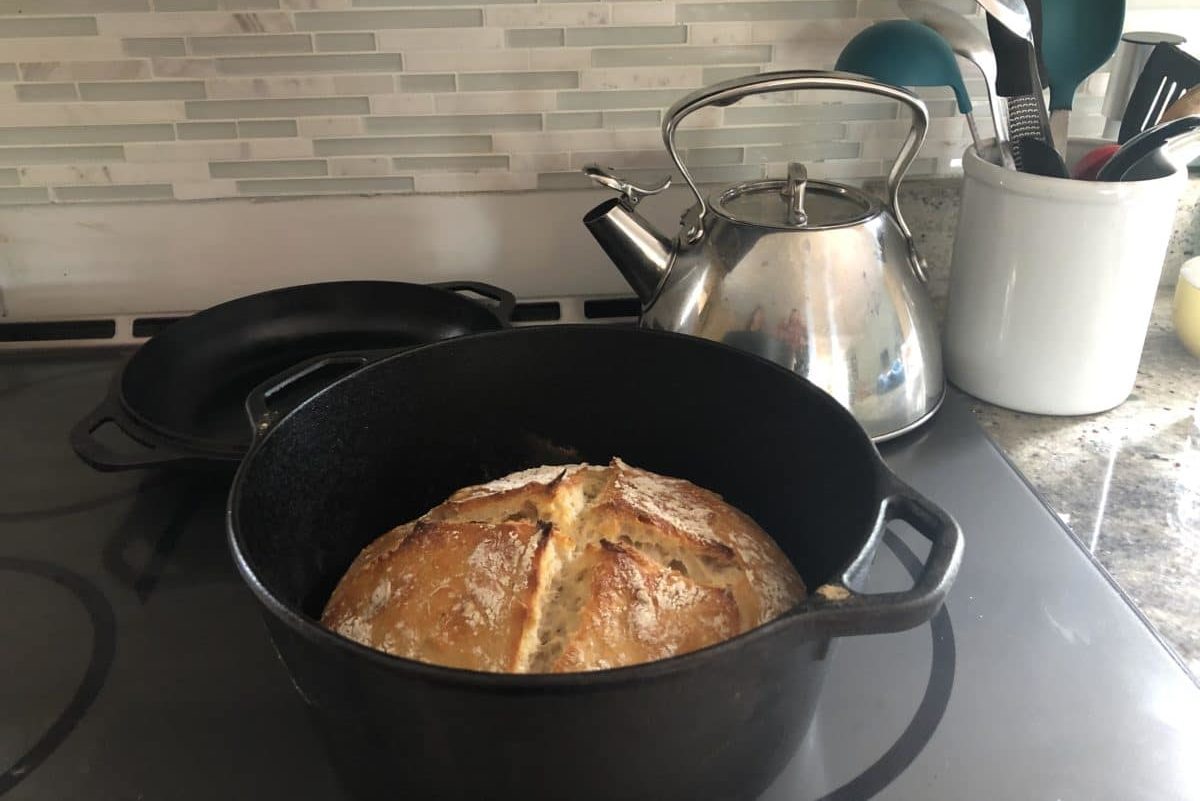I live in a quiet neighborhood in Brooklyn that is an even mix of first generation immigrants and true, honest-to-goodness Brooklynites. When I made my first mad dash to the grocery store to stockpile for the impending lockdown, I of course noticed the staggering gaps of emptiness in the aisles, especially the coveted essential paper goods we’ve all grown accustomed to for their ease and availability. I then realized the extreme extent of what was happening. The entire USA was facing a paper products shortage because of the quickly escalating pandemic. People urgently flooded grocery stores to buy up their paper towel, paper napkins, and toilet paper for fear that this pandemic meant never being able to leave their homes. You have to have the essentials. However, my neighbors and I also found another item to be absolutely crucial to prepare for a could-be apocalypse: flour. And then: yeast.
All three grocery stores within walking distance of my apartment were sold out of flour, and not a packet of yeast to be found. As the walls behind the shelves began making their appearance, so did the idea of moving to safer ground. The city shut down, New. York. City. Closed! The city that never sleeps! Well, it was now in a coma. This is when it really hit home; no toilet paper, no flour, no yeast. The apocalypse was becoming too real. Reality sunk in and the realization that there was no place like home loomed in our faces. My hometown in New Hampshire beckoned and a few friends and I departed to the safest place to quarantine, home.
In early March, I moved back in with my mom (every twenty-something’s dream!). Social distancing was in place, but being cooped inside was not an option. I ventured on an expedition to cure both issues, getting out of the house and trying to be social. I met up with my best friend from high school who had also moved home. On a quarantine run, we trotted on opposite sides of the road as we made our way around the eerily quiet neighborhood of long driveways, grassy fields, manicured lawns and massive trees, yet another reminder of the void of my abandoned city. As we stretched out on the lawn, her mother appeared holding a mason jar of half filled with tannish, I wasn’t sure, goop? What I acquired that fateful day that set me on my quarantine quest was a 200 year old French sourdough starter.
I now had a purpose and committed myself to researching everything that I possibly could about baking sourdough bread. It turns out that caring for a sourdough starter is much like caring for a very small, very needy child. It’s recommended that they be fed every 12 hours, unless, of course, it’s warm, then they need to be fed more frequently. Then again, if it’s cold, it must be fed more like every 14-15 hours. Starter is very particular. Mine personally likes to be fed every 12 hours and MUST be kept at a strict temperature of 24°C (75°F.) or else it refuses to rise.
It took me a frustratingly long time to figure out how to care for my particular starter, who I eventually named Françoise. I kept her in the mason jar with the metal jar lid she came with. I would later learn, to my utter dismay, the metal lid was apparently only meant to keep her covered for her journey home. It took me nearly a month to figure out that starter fares best with a fitted cotton cloth over the top, not a solid lid. Starter is a
living organism composed of fermented water, airborne yeast, and flour. In order for it to thrive and rise properly, it feeds off of the natural yeast in the air that it pulls through the holes in cloth, allowing the starter to breath. Françoise let me know the error of my ways when one day she became so agitated, and so overly active that she burst through the glass mason jar in an explosion of cracking and explosive glass shooting clean across my mother’s spotless kitchen. That was when I knew the mason lid existed only for transportation purposes. I was able to revive Françoise and make her more at home in a new jar with a cotton lid.

Once the specific care of your own starter has been determined, baking can begin! It does take some time to really figure out the process, so I recommend waiting a few days before you actually start to bake. This will give you time to coax out all the little nuances needed in its finicky care that will give you the perfect bubbly, active starter you so desire, right in your very own quarantine kitchen. Truly active starter is the key to making the perfect sourdough loaf. The starter is what makes the bread rise and gives it that signature tang that makes it so unique. If your starter isn’t light, fluffy, and filled with bubbles, your bread won’t rise. It’ll come out looking flat, dull, and dense when you cut into it. Although it still tastes good it has the texture of a brick!

I also learned quickly that you really do need a baking scale to get the right proportions of water and flour. A perfect ratio of 1:1:1 of water, starter, and flour is desired. It turns out that Googling, “how many grams of water are in a tablespoon” does not exactly give the most accurate measurement. Devoting the time and effort it takes to bake sourdough bread warrants the investment in a small baking scale, trust me on this one, it’s worth its weight in gold.
Since quarantine began, I have made upwards of ten loaves of sourdough bread. Each one has created its own unique experience. The very first loaf had the most contentious challenges, as most firsts do. In time, I managed to scrounge up a bag of all-purpose flour from a neighbor, then I stumbled upon a bag of organic all-purpose in the specialty aisle of a supermarket, albeit at a hefty price, but I grabbed it. And then, lo and behold, I found the coveted
bread flour sitting forlornly at the back of a dusty shelf of an old 1950’s supermarket. I miserly accumulated these prizes in my mother’s vast kitchen. As the days slowly crept by, my acquaintance with this new form of baking began. I tried using all three flour types in different amounts.
To my surprise I found that organic all-purpose was not only the least temperamental, but it also rose the best in the oven (worth those extra dollars after all). Regular all-purpose made for a less risen, and denser loaf. The bread flour, although it was the recommended variety, worked best when ½ of the amount was replaced with the organic all-purpose. My experimentation was working. I learned that the type of flour used is most important because bread requires a higher protein content than other baked goods because the gluten-protein is the agent in it that allows the bread to rise and maintains that network of bubbles on the inside and the desired crunchy crust of an exceptional bread loaf. Self rising flour has baking powder and salt already added to all-purpose flour, which isn’t necessary with sourdough bread; a good thing that wasn’t on the store shelf. This surely was an educational experience!
Now we all know the importance of starters is to make the bread rise. Equally as crucial though, is the environment. Humidity is critically important. If the air is too humid, your bread requires more flour to rise. If it is too dry, you may need more starter or more water. Bread rises quicker in warm environments and much slower in cooler environments. One must pay extreme attention to the atmosphere you are working with to achieve that perfect loaf.
Like I said, sourdough is like a needy child. After 8 hours of rising, it’s best to check on it every 30 minutes to an hour until it’s doubled in size. Most people would say that once you’ve made it past the overnight rise, the hard part is over. In my experience that is far from the truth. Actually baking the bread is its own experience. You need to be really well acquainted with your oven. Different recipes will give you varying recommendations for cooking times but really it all depends on your own oven. My mother’s oven, my sourdough test oven, is personally really hot! I’ve learned to take my bread out earlier than most recipes recommend. A covered dutch oven keeps your loaf nice and moist without burning the crust on top, but to get that yummy crunch every bread lover looks forward to, take the lid off for the last 15 minutes or so. This gives the crust that extra crispness when you bite into it. Another trick I would recommend is placing a cool cookie sheet underneath your dutch oven while the bread is baking. This will block the excess heat from below from scorching the bottom of your bread, as it distributes the heat more evenly across the bottom of the dutch oven.
If you have successfully cared for your starter, followed your recipe, accounted for the environment, and found the perfect covered to uncovered ratio when baking, you will find yourself with a gorgeous loaf of sourdough bread! My first fruitful loaf was so good that my entire family gathered around our old family kitchen table and devoured the whole loaf using only a little butter and jam! To get to this point, it truly was a labor of love but the end result of a warm, crusty, tangy loaf of sourdough bread was worth every bubbly moment. My thoughts were not lost as I looked around at the warm faces of my large family eagerly enjoying my creation, quarantined together inside our childhood home. Who would have thought we’d ever have this kind of time together? A slower pace, a pause in time to really appreciate the simpler things. We’d all gone off in our own adult-ish directions; ah, the silver lining of a sourdough journey.
Should you choose to accept the mission of keeping a living breathing creature in your cupboards, it doesn’t have to be an all consuming affair. If you don’t feel like caring for your needy starter, you can just place it in your fridge and put your child to bed. The jar will sulk and sleep in the back of your refrigerator until the day arises that you feel the urge to mix and wait and smell the earthy aroma of starter doing its thing, creating bubbles of yeasty goodness growing in its home. Another benefit to feeding your starter is how quickly and easily it reproduces, it can then be shared, just pour ½ of the bubbly mixture into another jar, cover with a mason jar lid and gently offer it up to an unsuspecting quarantined friend. A labor of love like sourdough starter is meant to be shared. Although sourdough is sour in flavor and it certainly can be a sour process to make, after all the hard work and effort and failed attempts, that first bite of fresh-out-of-the-oven bread and the warmth and heavenly smell in the kitchen makes a house a home. It makes a stay-at-home order a little easier to bear.![]()
